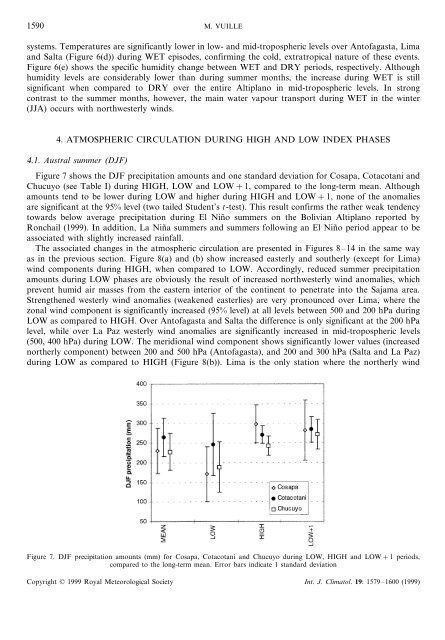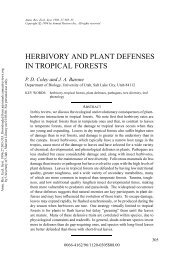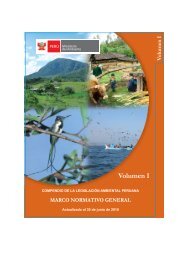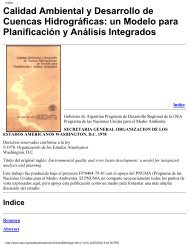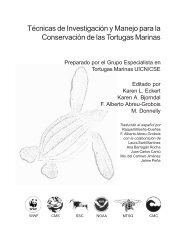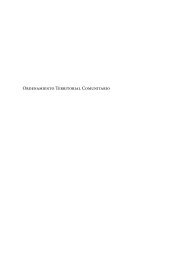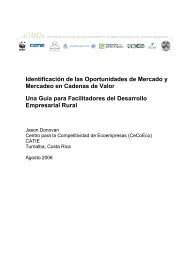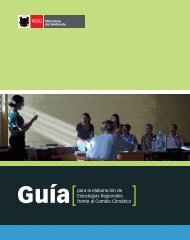Atmospheric circulation over the Bolivian Altiplano during ... - CDAM
Atmospheric circulation over the Bolivian Altiplano during ... - CDAM
Atmospheric circulation over the Bolivian Altiplano during ... - CDAM
Create successful ePaper yourself
Turn your PDF publications into a flip-book with our unique Google optimized e-Paper software.
1590M. VUILLEsystems. Temperatures are significantly lower in low- and mid-tropospheric levels <strong>over</strong> Antofagasta, Limaand Salta (Figure 6(d)) <strong>during</strong> WET episodes, confirming <strong>the</strong> cold, extratropical nature of <strong>the</strong>se events.Figure 6(e) shows <strong>the</strong> specific humidity change between WET and DRY periods, respectively. Althoughhumidity levels are considerably lower than <strong>during</strong> summer months, <strong>the</strong> increase <strong>during</strong> WET is stillsignificant when compared to DRY <strong>over</strong> <strong>the</strong> entire <strong>Altiplano</strong> in mid-tropospheric levels. In strongcontrast to <strong>the</strong> summer months, however, <strong>the</strong> main water vapour transport <strong>during</strong> WET in <strong>the</strong> winter(JJA) occurs with northwesterly winds.4. ATMOSPHERIC CIRCULATION DURING HIGH AND LOW INDEX PHASES4.1. Austral summer (DJF)Figure 7 shows <strong>the</strong> DJF precipitation amounts and one standard deviation for Cosapa, Cotacotani andChucuyo (see Table I) <strong>during</strong> HIGH, LOW and LOW+1, compared to <strong>the</strong> long-term mean. Althoughamounts tend to be lower <strong>during</strong> LOW and higher <strong>during</strong> HIGH and LOW+1, none of <strong>the</strong> anomaliesare significant at <strong>the</strong> 95% level (two tailed Student’s t-test). This result confirms <strong>the</strong> ra<strong>the</strong>r weak tendencytowards below average precipitation <strong>during</strong> El Niño summers on <strong>the</strong> <strong>Bolivian</strong> <strong>Altiplano</strong> reported byRonchail (1999). In addition, La Niña summers and summers following an El Niño period appear to beassociated with slightly increased rainfall.The associated changes in <strong>the</strong> atmospheric <strong>circulation</strong> are presented in Figures 8–14 in <strong>the</strong> same wayas in <strong>the</strong> previous section. Figure 8(a) and (b) show increased easterly and sou<strong>the</strong>rly (except for Lima)wind components <strong>during</strong> HIGH, when compared to LOW. Accordingly, reduced summer precipitationamounts <strong>during</strong> LOW phases are obviously <strong>the</strong> result of increased northwesterly wind anomalies, whichprevent humid air masses from <strong>the</strong> eastern interior of <strong>the</strong> continent to penetrate into <strong>the</strong> Sajama area.Streng<strong>the</strong>ned westerly wind anomalies (weakened easterlies) are very pronounced <strong>over</strong> Lima, where <strong>the</strong>zonal wind component is significantly increased (95% level) at all levels between 500 and 200 hPa <strong>during</strong>LOW as compared to HIGH. Over Antofagasta and Salta <strong>the</strong> difference is only significant at <strong>the</strong> 200 hPalevel, while <strong>over</strong> La Paz westerly wind anomalies are significantly increased in mid-tropospheric levels(500, 400 hPa) <strong>during</strong> LOW. The meridional wind component shows significantly lower values (increasednor<strong>the</strong>rly component) between 200 and 500 hPa (Antofagasta), and 200 and 300 hPa (Salta and La Paz)<strong>during</strong> LOW as compared to HIGH (Figure 8(b)). Lima is <strong>the</strong> only station where <strong>the</strong> nor<strong>the</strong>rly windFigure 7. DJF precipitation amounts (mm) for Cosapa, Cotacotani and Chucuyo <strong>during</strong> LOW, HIGH and LOW+1 periods,compared to <strong>the</strong> long-term mean. Error bars indicate 1 standard deviationCopyright © 1999 Royal Meteorological Society Int. J. Climatol. 19: 1579–1600 (1999)


